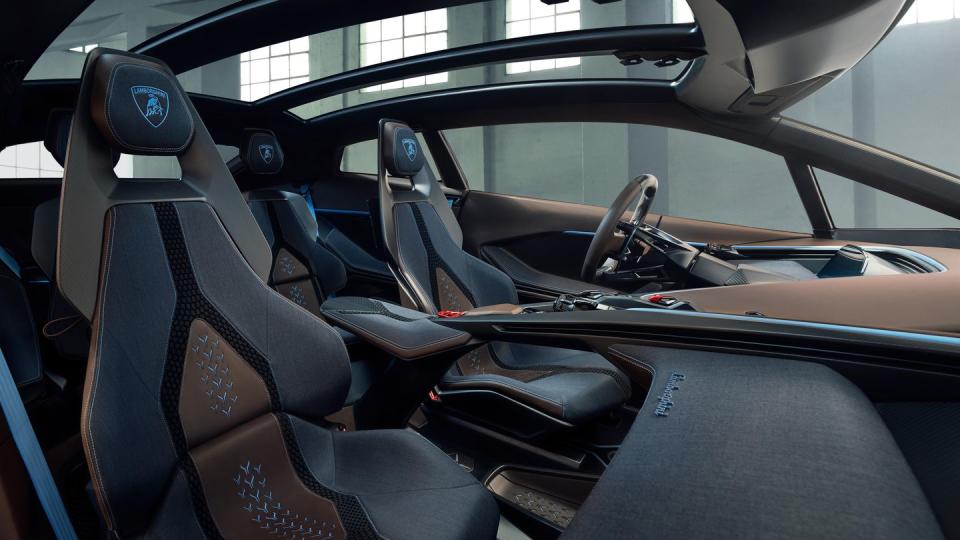Don't Call the Lamborghini Lanzador a Crossover—and Don’t Expect to See It Soon

Concept cars afford manufacturers the ability to engineer and design outside the box without any real strings attached. Sure, each concept car is tailored to the badge on its hood, with Toyota concepts being more consumer-focused than Lamborghinis.
But a brand like Lamborghini actually has even more room to play, as the potential price is less important for its customers. That doesn't mean Lamborghini can do whatever it wants, however. With decades of Italian design lineage and a history of large displacement internal-combustion engines, going electric could easily rock the boat.

When it comes to forging ahead into the future though, maybe rocking the boat isn't such a bad thing. At least that's how Lamborghini's Chief Technical Officer Rouven Mohr sees it, as we step over the short chainlink fence dutifully protecting the Concept Green at the Pebble Beach Concours d'Elegance.
That's because Lamborghini has just launched its newest concept, the Lamborghini Lanzador. Branded as a high-ground-clearance GT with 2+2 seats, the Lanzador is not groundbreaking because of its seating capacity. On the contrary, owners of the Lanzador will be encouraged to take passengers, especially because you'll be able to hear them so well.
What's controversial about the Lanzador is that it's battery-electric. Following in the footsteps of the plug-in hybrid Lamborghini Revuelto, the Lanzador runs on a new generation high-performance battery, boasting around 1360 hp. Unfortunately, this is the only number Lamborghini is sharing with the public.
That means we don't know the range, torque, battery size, or charging speed of the Lamborghini Lanzador, though the company has some time until it needs to decide, as the official launch year is set well into the future: 2028. But that doesn't mean Sant'Agata Bolognese's first battery-electric model is simply conjecture.

To learn more about the car, we chatted with Rouven Mohr, standing next to the dazzling Azzurro Abissale (blue) painted model. For starters, Mohr emphasized to me that this car is not a crossover—period. Rather, prospective buyers should look at it like a stretched and lifted Huracán.
This carries over into the design of the car, with a low roof and an even lower seating position. But in order to maximize its still-unknown range figures and emphasize its supercar heritage, Lamborghini spent most of its time on aerodynamics.
"It's very important that you have the right balance between aerodynamic resistances for the electric range and, nevertheless, it should still have supercar behavior," Mohr told Autoweek. "Therefore, you needed downforce for the setup of the car and we decided to have a lot of active aero solutions, too."

That's right, active aero is present all around the Lanzador. From switchable front-end air vents and an air-blowing rear diffuser to front-fender hidden louvers and a side skirt channel that flows air over the rear tires, the aerodynamic properties of the Lanzador are its crown jewel.
But it's also a defining part of the model being an EV, Mohr explained. Cooling a battery producing 1360 hp is a challenge in its own right, but keeping range numbers high and a multi-thousand pound, lifted supercar planted on the road at the same time requires a lot of help from the air. A lack of exhaust systems and engine weight certainly factors into the equation.
Because this model is being marketed as a supercar, handling is obviously important as well. Reconciling a Subaru Crosstrek-style ride height with sharp handling isn't particularly hard, though Mohr explained a lot of the canyon-carving chops are owed to a complex, third-generation electronic handling system.

"With electric motors, we can control the wheel speed much more precisely. You can do things that you could not do with the combustion-engine versions," Mohr said. "It's less about the number of sensors and more about the algorithm and the precision of actuation."
By actuation, he is referring to the various adjustable facets of the Lanzador, including the steerable rear axle and air suspension. Depending on the mode selected, the Lanzador will completely re-configure its suspension and aerodynamic bits to provide an optimal driving experience. And the Lanzador is the first of its kind to test a new generation of accompanying software.

Most interesting of all, however, is the interior design. With an elongated, 2+2 configuration, the Lanzador looks spaceship-ready, an intentional design note. Lamborghini wants drivers to "feel like a pilot" inside and, to do so, it lowered the seat position and raised the shoulder line.
"The seating position is exactly as low as the supercar," Mohr noted. "You have the best of both worlds because people like to sit a little bit higher, yet they don't want to sit on top of the car."
This aerospace-style design carries over into the steering wheel shape and buttons, though such seats would never be allowed in a trainer or commercial aircraft. But because this is a concept, Lamborghini took it a step further, offering recycled materials throughout the cabin.
Regenerated nylon, 3D-printed recycled fibers, and regenerated carbon make up the majority of interior materials. That said, some leather is present, though the company says it was tanned in a way that reduces water waste.
Altogether, the Lamborghini Lanzador is about as cool as a concept car gets. With so few battery-electric, hypercar-fast, European-pedigreed models on the market, Lamborghini is hoping to create a demand and craze for Italian EVs. In other words, this won't be traditional customers but rather new, young folks, and that's just fine by Lamborghini—assuming those shopper can wait several years.
Do you think any current EVs available today are competitive with the Lamborghini Lanzador? Please share your thoughts below.

 Yahoo Autos
Yahoo Autos 